Sungold SGF3-300 Watt Solar Panel
- Home
- »
- Sungold SGF3-300 Watt Solar Panel
Sungold SGF3-300W Solar Panel
- Brand: Sungold
- Cells Efficiency :22.70%
- Folding Size: 980*770*35mm
- Unfolding Size: 1543*980*35mm
- Surface Material: glass
- Warranty: 10 years
Description
The Sungold solar SGF3 is an eco-friendly, highly efficient, and convenient 300 watt 12V monocrystalline foldable suitcase solar panels. 300 watt solar panel for RV are thoughtfully designed to cater to your RV power needs. With adjustable T-U aluminum brackets, sturdy latches, and heavy-duty handles, they are a portable and user-friendly solution, ideal for adventurous travelers. They offer both convenience and reliability when you’re on off-grid journeys.
Portability
High Efficiency
Durable
Easy to Use
SGF3-300 Watt Solar panel

T-U Bracket
The bracket of this product is made of aluminum alloy material, which is very durable and corrosion-resistant. The stand can be adjusted flexibly, and it is equipped with screws at the bottom. This screw can be moved to better face the sun and absorb sunlight.
Portability
The folded size of the SGF series 300 Watt solar panel is 980*770*35mm, which will not occupy extra space. Equipped with a sturdy carrying handle, we provide you with a stylish black bag that protects your solar panels. You can carry it anywhere, such as outdoor camping, RV travel, or in the event of an unexpected power outage.
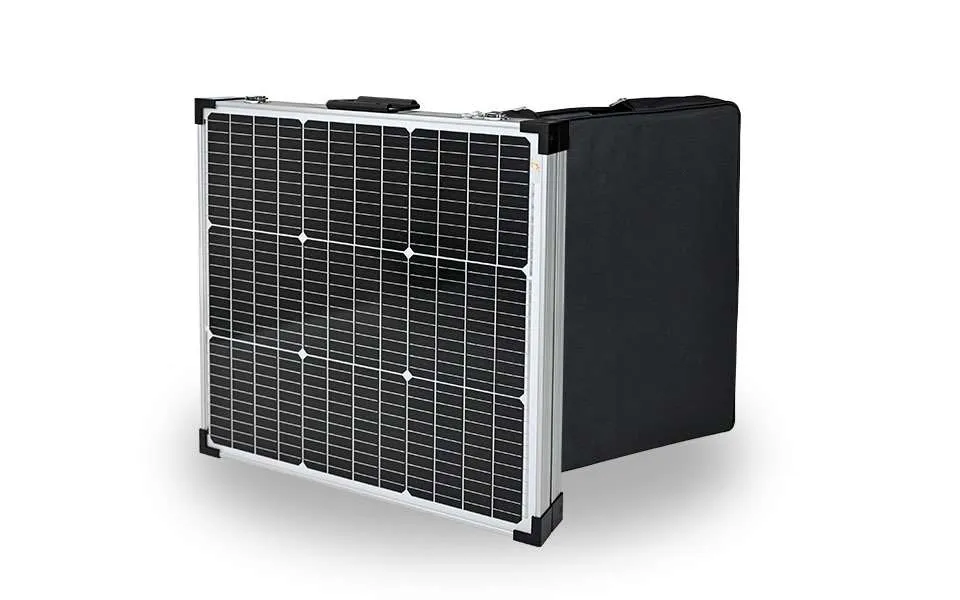
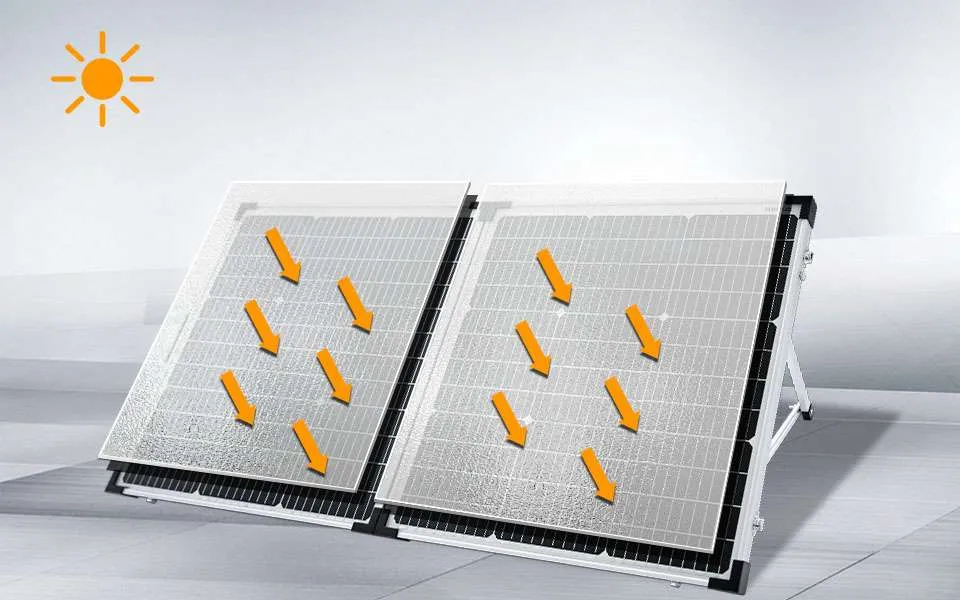
High Efficiency
Although the appearance of the latest SGF series products does not change much from the previous products, the power generation efficiency is improved with the progress of the cells. The current SGF 300 watt solar panel adopts 182 mono solar cells, and the cell efficiency is as high as about 22.7%. High-quality cells can make solar panels have higher conversion efficiency.
Durable
The frame and bracket of the SGF 300 watt glass folding solar panel are all made of aluminum alloy material, which ensures the corrosion resistance and aging resistance of the solar panel. Its overall design is heavy, stable, and has strong wind resistance. Even if it is exposed to rain, it will not damage the performance of the solar panel.
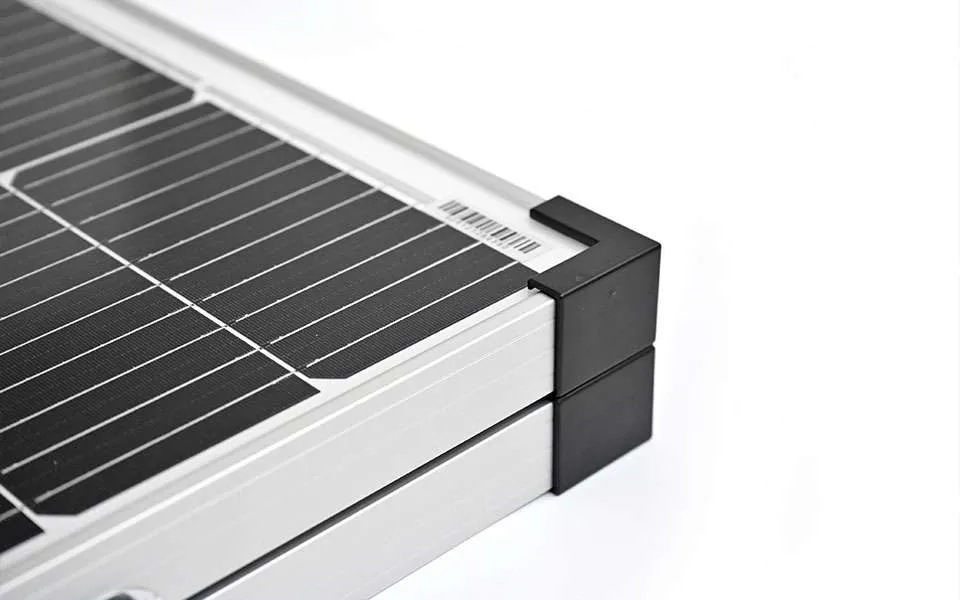
RIGID SOLAR PANELS 300W
Solar panels 300 watt consists of two 150w monocrystalline glass solar panels, the power generation efficiency is as high as 22.70%, durable and efficient. Suitcase solar panels take up little space, convenient and easy to carry with the power station to provide off-grid power to meet the demand of RV, camping, marine, and other outdoor scenes. The Suitcase solar panel takes up little space, is easy to carry, and can be used with power station to provide off-grid power for RV, camping, marine, and other outdoor scenarios.
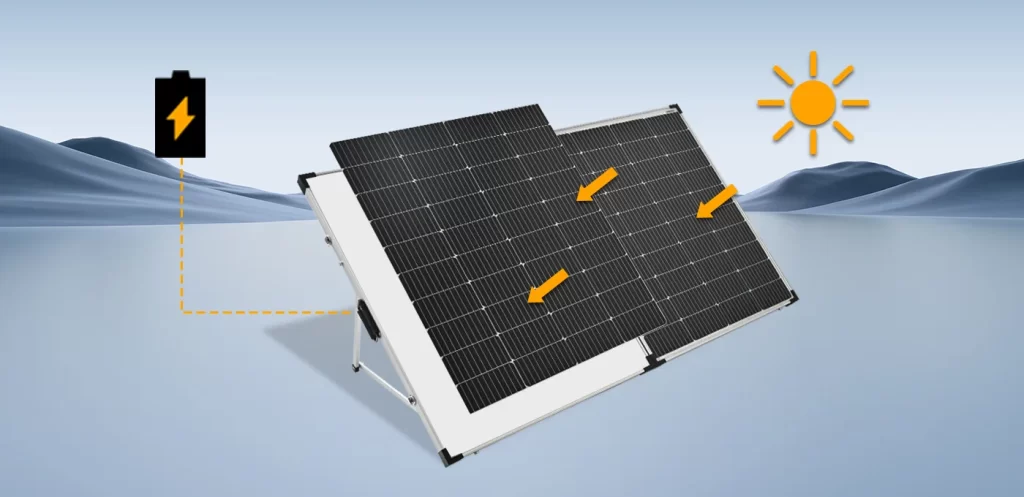
More Power and Flexibility
The 300 watt solar panel utilizes high quality monocrystalline cells with an output efficiency of up to 22.70%, making it more efficient and stable. Plug and play for easy charging, it can also be easily integrated into existing solar systems to power the battery bank together with the charge controller.
The T-U adjustable mount is easy to install and requires only a small change in angle for optimal sunlight, ensuring that you always get enough energy. Giving you more flexibility and possibilities for your outdoor adventures and RV life.
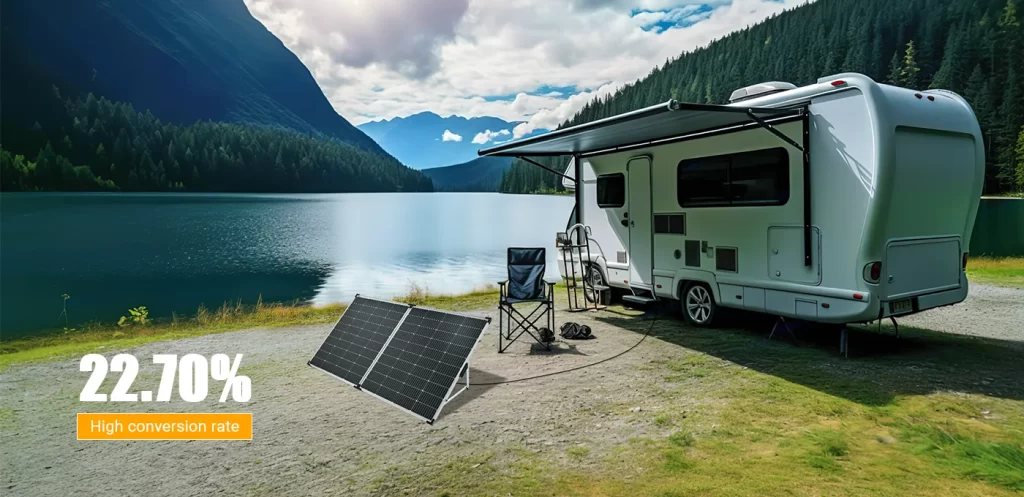
Small Size, Easy to Carry and Store
300 watt solar panel folding design minimizes in size, the unfolded size is 1543*980*35mm, and only 980*770*35mm after folding, which won’t take up too much space whether you put it flat or stand it up.
After folding, the wiring is placed in the center of the panel without taking up extra space. The travel case can be easily carried around or stored in any crevice of your caravan or van, providing you with convenient power supply.
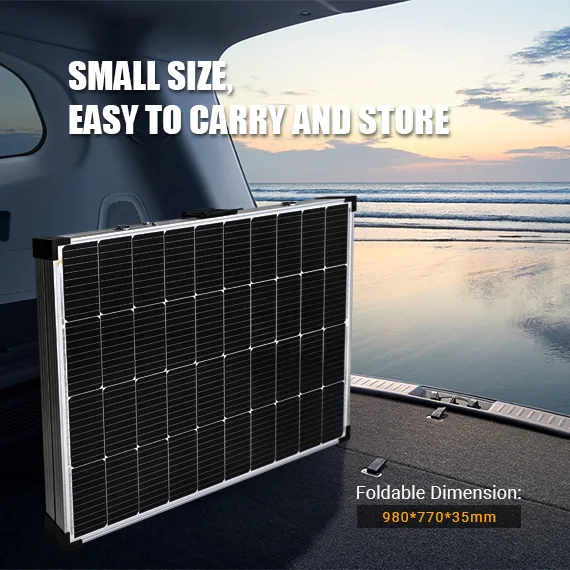

Sturdy Off-Grid Power Supply
The 300 watt solar panel comes with a 10-year product warranty and has a lifespan of up to 25 years. Made of sturdy tempered glass and aluminum frame and designed with edge protection to better protect the solar cells.
Suitable for solar generators, portable power stations, emergency backup or remote power, the 300w suitcase solar panel is an excellent off grid solar solution for camper vans and trailers.
Specifications
The folded size of the SGF3-300 Watt solar panel is 980*770*35mm, which will not occupy extra space. You can carry it anywhere, such as outdoor camping, RV travel, or in the event of an unexpected power outage.
| Parameter | Value |
|---|---|
| Product | SGF3 300W |
| Maximum Power/Pmax (Wp) | 300W |
| Folding Number | 2pcs |
| Cell Efficiency | >22.7% |
| Number of Cells | 2*4*10 |
| Operating Voltage/Vmp (V) | 23.2 |
| Operating Current/Imp (A) | 13.16 |
| Open Circuit Voltage/Voc (V) | 27.1 |
| Short Circuit Current/Isc (A) | 13.58 |
| Folded Size (mm) | 1000*770*35mm |
| Expand Size (mm) | 1543*1000*35mm |
| Solar Cells | 182 mono cell |
| Weight (kg) | 3.92 |
| Maximum System Voltage | 100V DC(IEC) |
| Connector | Anderson |
| Color | White |
| Warranty | 10 years |
FAQ
To determine the size of the cable for a 300W solar panel, you need to consider the Amps and voltage involved in the system.
Calculate Amps: Start by determining the maximum current (Amps) that the 300 watt solar panel will generate. Divide the power output (300W) by the system voltage (e.g., 12V or 24V) to get the current. For example, if it’s a 12V system: 300W / 12V = 25 Amps.
Select the Wire Size: After calculating the Amps, refer to an “ampacity chart” to find the appropriate wire size that can handle the current without significant voltage drop or heating issues. Consider the various connections in your solar setup, such as panel to charge controller, charge controller to battery, and battery to inverter.
Oversizing the Wire: If you’re unsure about the exact wire size to use, it’s generally safer to choose a slightly larger wire gauge than the minimum required by the ampacity chart. A larger wire will have lower resistance and can handle more current with less voltage drop.
Consider Voltage: Higher voltage systems typically experience less voltage drop over longer cable runs, so if you have a choice, consider using higher voltage setups (e.g., 24V or 48V) for longer distances.
Insulation and Conduit: Ensure that the wire you use has proper insulation suitable for high rooftop temperatures and the high voltage that solar panels can produce. For added safety, protect the wires in grounded metal conduit to prevent any electrical hazards.
MPPT Charge Controller: If you’re using a 12V 100Ah battery with a 300W solar panel, a proper MPPT (Maximum Power Point Tracking) charge controller is recommended to efficiently charge the battery and make the most of the available solar energy.
Remember to study local codes and the National Electric Code (NEC) for solar panel installations to comply with safety regulations. If you are unsure about specific aspects of the installation, consider consulting a qualified electrician or solar expert to ensure a safe and efficient setup.
Yes, a 300 watt solar panel can charge a 12 volt battery, but you need a solar panel controller that supports both voltages. Most controllers on the market can handle 12 volt batteries, but the key is to make sure the controller can handle the current generated by the solar panel. In this case, you will need to handle 25 amps of current (300 watts/12 volts = 25 amps).
To be on the safe side, it is recommended to choose a controller with a slightly higher current rating, such as a 30 amp controller. There are two main types of controllers: PWM (Pulse Width Modulation) and MPPT (Maximum Power Point Tracking).
PWM controllers are more affordable, while MPPT controllers are slightly more expensive but offer better performance, especially in low light conditions. If you plan to use solar panels extensively or need more power, investing in an MPPT controller may be a wise decision.
It’s true that 300-watt solar panels can charge 12-volt batteries, but it’s important to choose a compatible solar panel controller with the proper amperage rating for a safe and efficient charging process. If possible, consider investing in an MPPT controller for better performance, especially in challenging lighting conditions or demanding applications.
You might think that the answer is a 300 watt controller but actually it depends on the voltage of the battery you are using. For example, you can get a 300 watt controller which works at 12 volts and also at 24 volts. The 300 watt rating will apply to the highest voltage the controller is rated for. That would mean 24 volts which at 300 watts is 300/24 = 12.5 amps. So the same controller at 12 volts would only be good for 150 watts.
You need at controller which can handle the current you will be able to deliver at the voltage of your system.
Yes, a 300-watt solar panel can potentially run a fridge, but it depends on the specific power requirements of the refrigerator and other factors such as the location, climate, and the availability of sunlight.
Most refrigerators typically use between 300 and 600 watts of electricity when running. If your fridge falls within this power range and you have a 300-watt solar panel, it may be able to provide enough electricity to power the fridge under certain conditions.
However, it’s essential to consider that solar panels don’t produce their maximum rated output all the time. The actual power output of a solar panel will vary throughout the day based on factors such as sunlight intensity, shading, and panel orientation. Additionally, solar panels don’t generate power during the night.
To ensure your fridge receives a consistent power supply, you would need to use a battery storage system to store excess energy generated during sunny periods. The battery can then be used to power the fridge during the night or when the solar panel output is insufficient.
The power output of a solar panel is measured in watts, not kilowatt-hours (kWh). A 300-watt solar panel can produce a maximum of 300 watts of power under ideal conditions.
The energy production of a solar panel is measured in kilowatt-hours (kWh) and depends on various factors, such as location, orientation, tilt, shading, and weather conditions. As you mentioned, a 300-watt solar panel can generate about 2.5 kWh of energy per day under average conditions.
A 300-watt solar panel will produce 300 watt-hours (Wh) of electricity if it operates at its full capacity (300 watts) for one hour. So, the power output of a 300-watt solar panel per hour is 300 watt-hours (Wh) or 0.3 kilowatt-hours (kWh).
To calculate the approximate time it takes to charge a battery with a solar panel, you need to consider various factors, including the battery’s capacity, the solar panel’s output, and the efficiency of the charging process. Let’s do the calculation:
Assumptions:
Battery capacity: 100 ampere-hours (Ah)
Battery voltage: 12 volts
Solar panel output: 300 watts
Step 1: Calculate the energy required to fully charge the battery:
Energy (in watt-hours) = Battery capacity (Ah) × Battery voltage (V)
Energy (in watt-hours) = 100 Ah × 12 V = 1200 watt-hours (Wh) or 1.2 kilowatt-hours (kWh)
Step 2: Calculate the time it takes to charge the battery with a 300W solar panel:
Time (in hours) = Energy required (Wh) ÷ Solar panel output (W)
Time (in hours) = 1200 Wh ÷ 300 W = 4 hours
So, with a 300W solar panel, it would take approximately 4 hours to fully charge a 12V 100Ah battery under ideal conditions. However, please note that real-world factors like solar panel efficiency, weather conditions, and charge controller efficiency can affect the actual charging time. It’s always a good idea to consider a safety margin and monitor the charging process carefully.
A 300W solar panel can generate up to 300 watts of power under ideal conditions. The actual output of the solar panel will vary depending on factors such as sunlight intensity, angle of sunlight hitting the panel, temperature, and shading.
With a 300W solar panel, you can power various devices or appliances, depending on their power requirements and the amount of sunlight available. Here are some examples of what a 300W solar panel could potentially run:
Small electronic devices: Laptops, smartphones, tablets, and other small electronic devices can be powered directly from the solar panel through a power inverter or a solar charger.
LED lights: Energy-efficient LED lights consume relatively low power, and a 300W solar panel could power several LED lights for indoor or outdoor lighting.
Small household appliances: Energy-efficient appliances like fans, small refrigerators, and some small kitchen appliances can be powered by a 300W solar panel.
Water pumps: Depending on the pump’s power requirements, a 300W solar panel could be used to operate a small water pump for irrigation or water circulation.
Camping equipment: A 300W solar panel can be used to recharge batteries for camping equipment like lanterns, flashlights, and portable coolers.
Actual runtime and capacity of the solar panel will depend on the specific devices you are using, the battery storage system, and the local solar conditions. If you have specific devices or appliances in mind, it’s best to check their power ratings and calculate their energy consumption to see if they can be adequately powered by a 300W solar panel.
Whether a 300W solar panel is enough to meet your electricity demand depends on your energy consumption and how much electricity you need to generate. Let’s break down the calculation:
A 300W solar panel can produce 300 watts of electricity per hour under optimal conditions (full sunlight). In a day with an average of 5 hours of peak sunlight, it can produce 300W x 5 hours = 1500 watt-hours or 1.5 kilowatt-hours (kWh) of electricity per day.
If you have only one 300W solar panel, it will produce around 1.5 kWh per day. This may be enough to power some small devices or appliances but is unlikely to meet the total electricity demand of a typical household.
If you want to fully offset your electricity consumption with solar energy, you’ll need to calculate your daily electricity consumption and then determine the number of 300W solar panels required to meet that demand.
Solar panels may not always operate at their full capacity due to factors like weather conditions, shading, and angle of installation. Therefore, it’s a good idea to add some extra capacity to your solar system to account for these variations and ensure you have enough power even on less sunny days.
While a 300W solar panel can contribute to your energy needs, a single 300W panel may not be enough to fully power a typical household. You’ll need multiple panels to meet your electricity demand, and the exact number will depend on your daily consumption and the local solar conditions. It’s recommended to consult with a solar professional to design a solar system tailored to your specific needs and location.
The time it takes for a 300-watt solar panel to charge a battery or a device depends on several factors, including the capacity of the battery or the power requirements of the device, the amount of sunlight available, and the efficiency of the solar panel and charging system.
To estimate the charging time, you can use the following formula:
Charging time (in hours) = Battery capacity (in watt-hours) / Solar panel output (in watts)
For example, if you have a 300-watt solar panel and want to charge a 300 watt-hour (Wh) battery:
Charging time = 300 Wh / 300 watts = 1 hour
This calculation assumes optimal conditions, such as full sunlight and no losses in the charging process. If you have specific devices or batteries you want to charge with a 300W solar panel, it’s best to check their capacity and efficiency to get a more precise idea of the charging time.
The power output of a solar panel is measured in watts, not kilowatt-hours (kWh). A 300-watt solar panel can produce a maximum of 300 watts of power under ideal conditions.
The energy production of a solar panel is measured in kilowatt-hours (kWh) and depends on various factors, such as location, orientation, tilt, shading, and weather conditions. As you mentioned, a 300-watt solar panel can generate about 2.5 kWh of energy per day under average conditions.
To estimate the yearly energy production, you can multiply the daily output (2.5 kWh) by the number of days in a year (365). This gives us an approximate annual energy production of 912.5 kilowatt-hours (kWh).
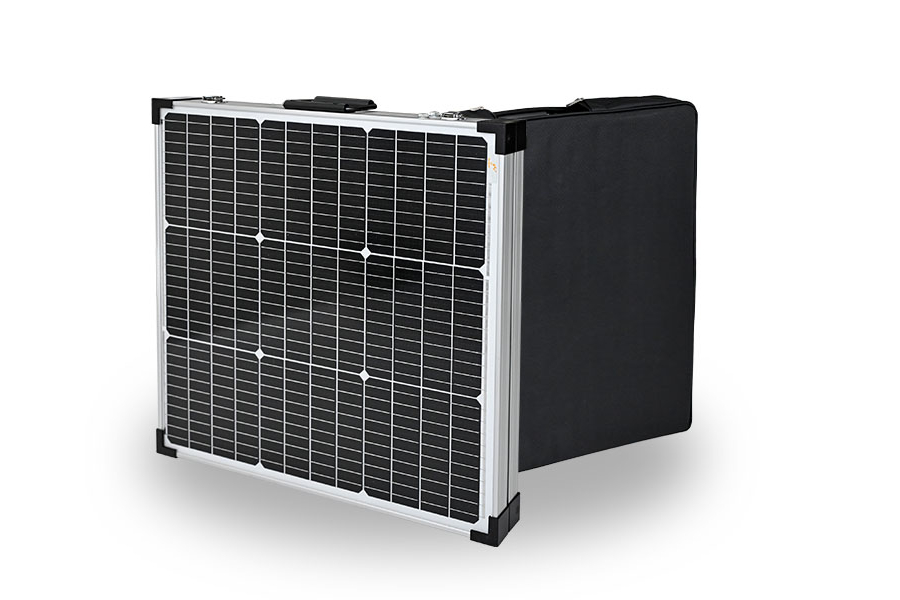
Download guide
The SGF series comes in an array of sizes and form factors, with peak power 300 watt , Download our guide to 300 watt solar panels
LEAVE A MESSAGE
If you are interested in our products and want to know more details,please leave a message here,we will reply you as soon as we can.

